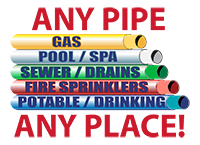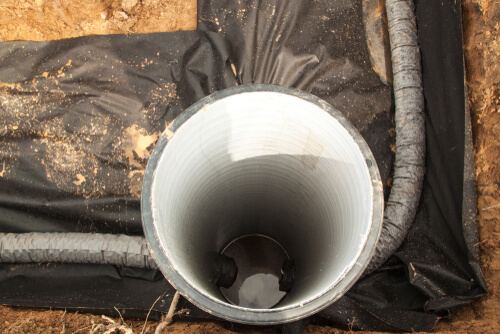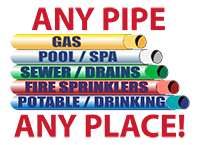We tend to take some essential things for granted as homeowners, and a well-functioning sewer line is probably one of the best examples of them. It’s only when you find out you have a broken sewer line that you understand how important they are.
Unfortunately, you’re probably already feeling the effects of having a busted line at that point. Don’t lose heart because that is a problem that you can promptly address.
In this article, we’ll talk about the different ways to approach sewer line repair. We’ll also touch on why your sewer line runs into problems in the first place and how you can prevent them. Stay tuned to find out what you can do to safeguard your home’s sewer line.
The Importance of the Sewer Line
Let’s get things started by first highlighting the importance of the sewer line.
The sewer line handles some dirty jobs for your household. The waste you flush down the toilet, throw down the sink, or let flow down the drain all wind up traveling to the sewer line at some point.
Your sewer line then takes all those waste materials and transfers them to the main sewer drain close to your property. Sewer lines have a downward slope to facilitate the proper movement of waste away from your home and into the main sewer line.
As you can probably imagine, problems may pop up inside your home if your line breaks. Your toilet, sink, and other drainage spots in your home may fail to clear. You’ll have a home stewing in filth.
That’s why addressing any issues related to your sewer line is so important. It also helps to be aware of the status of your sewer line. Watching out for certain things can help you determine if your sewer line is still in proper working condition.
The Symptoms of a Problematic Sewer Line
Like we noted above, keeping a close eye on your home’s sewer line is important. Close monitoring could save you from inconveniences and possibly repairs down the line.
Let’s identify some of the common symptoms of a broken sewer line in this section.
Draining Issues
Draining issues are probably the most common symptoms of a broken sewer line. The draining problems could emerge in different parts of your home.
It may be evident in your toilet producing an off-putting gurgling sound as it flushes. You may also notice that water accumulates along the floor of your shower even though you’re not bathing any differently. The drains inside your home may also be working slower.
Take those as possible signs you have a broken sewer line.
Changes to Your Yard
Typically, professionals install the sewer line underneath the yard. That placement is necessary because it must connect with the main sewer line.
Due to its position, you can tell if something’s wrong with your sewer line by looking at your yard.
Have you noticed that some sections of your yard appear to be growing better than others? That could be because there’s a leak underneath that spot.
Soft patches of soil are other possible indicators of a busted sewer line. Flooding is also another problem that could be caused by the sewer line.
Intruders Showing Up around Your Home
The sewers serve as a home for many insects and rodents. Most of them will stay down there in fear of what lurks outside. Every now and then, some of those creatures may venture beyond the sewer in search of nourishment.
If the crack in your sewer line is big enough, rodents and bugs can pass through it and use that as an entryway to your property. Consider taking a closer look at your line as soon as you see more of those unwanted house guests.
Water Damage
Hopefully, the problem doesn’t get to this point, but yes, water damage is a possible symptom of a busted sewer line.
A cracked sewer line can direct water back to your home and the walls specifically. Don’t be surprised to see mold growing along your walls as a result.
Water may also start to pool along the foundation of your home as it leaks out of the sewer line. Allow the water to soak your home’s foundation long enough, and you may soon see cracks start to form.
The Reasons Why Your Sewer Line Is Busted
Sewer lines are durable, but they are not impervious to damage. External elements can damage the line, as you’ll see in this section.
Traveling Tree Roots
Trees are remarkably resilient. They will find ways to survive even in seemingly poor conditions for them.
Part of the reason why trees survive so well is that their roots work hard to secure nourishment. Per this article from Earth.com, tree roots can travel hundreds of feet and pass through rock formations to find a reliable water source.
Unfortunately for you, the water source those tree roots find could be your sewer line. The tree roots may start to grow as they continually absorb nutrients from your sewer line. Eventually, they will grow and the increase in their size could damage the line itself.
Cold Weather
Low temperatures can be problematic for a sewer line. If there’s a small hole present, the cold air can pass through and gradually freeze the contents of the pipe. The frozen contents can then damage the pipe further.
Damage from Clogs
Even though the sewer line is different from most of the other pipes you have at home, it’s still prone to clogging.
Big objects intentionally or accidentally thrown down a drain can cause problems if it reaches the sewer line. Certain liquid substances such as cooking oil can also become sludge once inside the pipes and cause clogging.
With those items causing blockages, water may not pass through properly. The accumulating water may put pressure on the walls of the sewer line and cause them to burst.
Aging
Aging is inevitable for your sewer line. The constant flow of water and substances through the sewer line will cause a buildup of corrosion.
Like with the clogs, the corrosion can lead to more pressure on the walls of the pipe. All that increased pressure will cause cracks to form at some point.
Older pipes may also become incapable of working properly once they reach the end of their lifespan. Cement pipes can last for up to one hundred years, while cast iron pipes start to have serious problems once they hit seventy years.
The Methods of Repairing a Broken Sewer Line
There are two main ways of addressing a busted sewer line. Those two methods are pipelining and repiping.
In some cases, you can choose which method to use to repair your sewer line. However, it’s also possible the current condition of your sewer line will limit your repair options.
Pipelining
The process of pipelining involves using a special epoxy mixture to rehabilitate a broken pipe, or in this case, a busted sewer line.
Pipelining begins with cleaning out the sewer line. The presence of debris could limit the effectiveness of the epoxy mixture, hence the need to clean up first.
Professionals can place the epoxy solution inside the sewer pipe following the cleanup. Then they funnel conditioned air into the sewer line. The conditioned air’s job is to spread the epoxy mixture as equally as possible.
Air is continually pumped into the sewer line to facilitate the faster curing of the epoxy. After it hardens, the epoxy forms a new layer that serves as added protection. The epoxy also covers up any holes that were present along the sides of the sewer line.
Pipelining is an option to consider because it takes effect rather quickly. You don’t need to endure having a non-functioning bathroom or kitchen for too long.
Sadly, pipelining is not going to be a suitable solution in all scenarios. Sewer lines that are badly damaged may not benefit much from that new epoxy layer. They may still spring leaks even after pipelining.
Repiping
If pipelining is not enough to remedy your sewer-line related problems, you may need to turn instead to repiping. Repiping is another term for replacing a pipe.
Completely replacing a pipe becomes necessary when the one currently in place is beyond repair. Perhaps the tree roots have mangled the sewer line too much, or age has taken away the pipe’s ability to continue working properly.
The great thing about repiping is that it can enhance how your plumbing works. Introduce a new PEX or PVC pipe into your system and eliminate the nagging issues that accompany older pipes. Installing a new pipe can also lengthen the lifespan of your plumbing.
Replacing your old sewer line will take some time, but the benefits from doing so are more than worth it.
The Ways to Prevent a Broken Sewer Line
Homeowners should know that there are easily accessible methods of addressing their broken sewer line. Still, they would probably prefer to not make repairs at all.
Taking some precautionary measures can help protect your home’s sewer line better. Check out some of the preventative measures you can take below.
Evaluate the Trees and Plants Growing near Your Home’s Sewer Line
We’ve already discussed how tree roots could wind up damaging the sewer line under your yard. In search of a way to keep your sewer line protected, consider taking a closer look at the plants growing around your home.
According to The Spruce, the trees that should be kept far away from sewage systems are the larger, fast-growing trees. You want to avoid those plants because they have roots that tend to be aggressive, and there’s a good chance they will go into your sewer line. Specific trees you’ll want to avoid include ash, birch, and elm trees.
You should avoid growing plants close to your sewer line if possible, but if you want trees in your yard, stick to the ones that are shallow-rooted. Cherry, dogwood, and Japanese maple trees are among your top options.
Exercise More Caution When Using Drains inside Your Home
Being more careful can do wonders for your sewer line.
Instead of throwing everything down your sink when you’re cleaning up, take a moment to consider what you’re disposing of and how it could affect your plumbing. If you think that it can clog, try to come up with a different way of discarding it instead of hurling it down the sink.
You may also want to consider installing some drain guards. Those items can prevent larger pieces of debris from falling down the drains accidentally.
Perform Routine Maintenance
One more preventative measure you can take is to perform routine maintenance.
Take the time to inspect the drains in and around your home. Check if they’re working properly or if they’re having some issues. If those drains aren’t functioning correctly, they can affect the sewer line too.
Occasionally cleaning the sink and other drains inside your home is also a good idea.
You should call in professionals to check on your sewer line sporadically. They could spot a potential problem during one of their inspections and keep it from getting worse.
A broken sewer line can be a nightmare to deal with. Remember that you don’t need to do that on your own. Contact us at San Diego Plumbing & Pipelining and allow us to help with all your sewer line-related troubles.








